|
by Paul Haynie - Chicago, Illinois - USA |
Bill
Giles had hauled his boat most of a thousand
miles from Memphis, Tennessee, to Magnolia Beach,
Texas. He had the boat in the water and was standing
next to it when the Friendly Guy approached.
"Is that a boat?" the Friendly Guy asked.
"It looks like a shop project that didn't work
out. You don't really intend to take that out into
the bay, do you?"
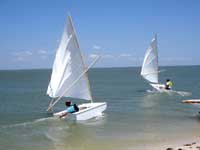 |
Yes, he
had already taken it out into the bay,
and No, it really wasn't a mistake.
(click
images to enlarge) |
|
Bill explained patiently that, Yes, the
Puddle Duck Racer (PDR for short) was
a real boat, and Yes, he had already taken it out
into the bay, and No, it really wasn't a mistake.
The Friendly Guy continued to ask skeptical questions,
and Bill began to consider offering to give him a
ride out to the middle of the bay and pushing him
overboard... And then the Friendly Guy couldn't hold
back the smile any more, and introduced himself as
Andrew Linn, fellow Puddle Duck
Racer builder and sailor. Andrew didn't have his boat
with him, but then, he had come three times as far
as Bill had, and he hadn't been able to figure out
how to conceal an eight foot boat in his carry on
luggage. Pleasantries were exchanged, and before very
long Andrew was out on the bay in Bill's boat.
| The Puddle
Duck Racer World Championships are, if anything,
deliberately NOT significant or prestigious;
significance and prestige would just get
in the way. |
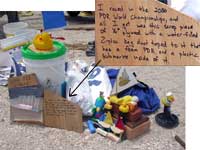
|
|
You'd think that when the participants in a race
travel an average of 850 miles to attend (to say nothing
of this rather demented spectator who drove an aging
Jeep Wrangler over 1200 miles just to WATCH) that
there would be a fair amount on the line, that the
prize or the prestige of the event would be significant.
In this case, you would be dead wrong. The Puddle
Duck Racer World Championships are, if anything, deliberately
NOT significant or prestigious; significance and prestige
would just get in the way.
Now, it should be understood that three and four
hundred mile journeys are not uncommon at messabouts;
that is just the nature of the boat building community.
It also seems that there are always one or two persons
at every such gathering who have traveled further.
By those terms, two time Champion (2005 AND 2006)
David Sargent's 300 mile "commute" from
Lake Charles, Louisiana, pretty much makes him "local".
But Bill Giles hauled his boat down from Memphis,
and Tim Cleary car-topped his boat more than 1100
miles from Greenville, South Carolina. Scott Widmier
split the difference between hauling a boat and flying
by flying in from Kennesaw, Georgia and building a
boat (in all of two days!) in Texas; class founder
David "Shorty" Routh flew in from Phoenix,
Arizona; Phil Keck flew in from Chicago; Andrew Linn
came all of the way from Salem, Oregon.
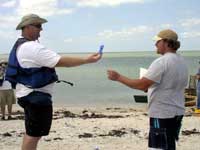 |
Class
founder David "Shorty" Routh
presents a prize to Jason Nabors
|
|
The question remains: Why? John Wright (who brought
THREE PDRs to Magnolia Beach; his own "Q&D
PDR", and two "loaner" boats built
to Shorty's specification for the use of the fly-in
types) has commented that the PDR is not so much a
boat as a "cultural catalyst", something
that avoids the "Pretty, Polished, Perfect, Pompous
or Pretentious" in favor of, as Grahame's Ratty
says, "Simply messing about in boats." It
is also true that the experience of hiking out to
windward as your boat crashes along with a bone in
her teeth is pretty much the same at 5 knots as it
is at 15 or even 25, and the magic of sailing a boat
you built yourself is pretty much the same whether
the same whether the boat is an 8 footer or a 30 footer.
Shorty designed the PDP in late 2003 as a follow
up to a $50 boat race; his mantra for the design and
the extremely informal organization that has grown
up around it is, "cheap, creative, and fun."
To date, the PDR has been an unqualified success.
When the first PDR championship was held in August,
2004, 16 of the boats had been built; a year later,
there were 52. As of the 2006 championships this May,
there were 104 (and it was up to 106 by the end of
the weekend); the Yahoo message board for the group
(pdracer) has more than 550 members.
| John Wright
brought THREE PDRs to Magnolia Beach; his
own "Q&D PDR", and two "loaner"
boats built to Shorty's specification for
the use of the fly-in types. |
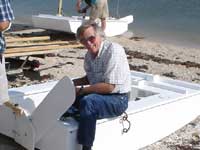
|
|
Shorty touts the PDR as the "easiest boat in
the world to build", and while the certainty
of that statement worries me, it is certainly the
simplest boat to build that I know of. Or at least
it would be, if there weren't so many design possibilities.
The class definition consists of a table of offsets
and a few simple rules that pretty much stop once
you are ten inches above the extreme bottom of the
boat. This has led to a bewildering array of bilge
keels, daggerboards, leeboards, and centerboards,
as well as a wide range of deck configurations. The
rigging rules are REALLY simple: Anything goes. The
most common sails are Sunfish-style lateens and sprit
boomed leg-o-muttons, but there have been gaffers
and lugs and Chinese lugs and spritsails and gunters;
there are rumors of crab claws and more exotic flip
tackers, and there is a three masted square rigger
in the works (to say nothing of the fellow who is
talking about powering a PDR with a Savonius wind
turbine...).
The Yahoo group is a big part of the reason for the
dedication PDR builders have to the class; it is at
least as much a club as a racing class. A recent post
stated, "I didn't come here to WIN, I came here
to RACE," which typifies the attitude of many
of the members; certainly no one OBJECTS to winning,
but no one really minds not winning very much. It
is certainly a VERY egalitarian and friendly club;
membership depends on taking an interest, and nothing
else. It is easy and entirely appropriate to consider
everyone else on the board a friend, and the prospect
of meeting several internet friends in one session
was a significant attraction of the race; Andrew's
"Friendly Guy" stunt was based on the utterly
valid assumption that the fellow he was harrassing
was ALREADY a friend of his, he just didn't know WHICH
friend, yet.
Rogues
Gallery |
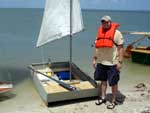
Andrew Creamer
Conroe, Texas |
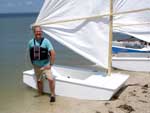
Andrew Linn
Salem, Oregon |
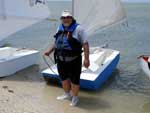
Bill Giles
Memphis, Tennessee
|
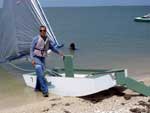
David Sargent
Lake Charles, Louisana |
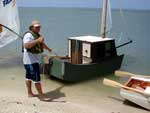
Jason Nabors
San Antonio, Texas |
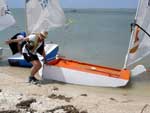
John Wright
Bastrop, Texas |
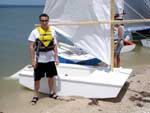
Phil Keck
Chicago, Illinois |
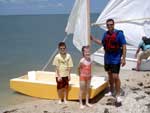
Scott Widmier
Kennesaw, Georgia |
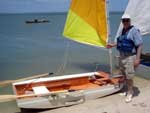
Tim Cleary
Greenville, South Carolina |
Oh, yes: The race itself. After a pair of match races
among Phil, Shorty, and Andrew Linn to determine who
got to use the two loaner boats (Shorty was eliminated),
the nine remaining racers drew numbered popsicle sticks
to determine starting order for the Le Mans style
start off the beach. Scott Widmier won the position
closest to the windward mark, and Dave Sargent volunteered
to take the furthest position out. Dave's "generosity"
paid off, as he stayed clear of a traffic jam at the
start and was first around the leeward mark, and held
that position for two more turns (and MANY tacks)
until Phil Keck managed to edge past him to be the
first to finish the second of three laps. Dave retook
the lead on the last downwind leg, and held onto the
lead upwind to finish first. The final standings were:
1, Dave Sargent; 2, Phil Keck; 3, Scott Widmier; 4,
Andrew Linn; 5, John Wright; 6, Bill Giles; 7, Tim
Cleary; 8, Andrew Creamer; 9, Jason Nabors; 10, David
"Shorty Pen" Routh.
Paul Haynie
6/12/2006
About the Puddle Duck Racer:
The PDR is a restricted design racing class
developed in early 2004 by David (Shorty Pen)
Routh. It is touted as the easiest boat in the
world to build, and it certainly can be, if
one doesn't get fancy. As I write this, 100+
hull numbers have been assigned, with more boats
always under construction. The greatest concentration
of boats is currently in Texas, but there are
fleets in 18 different states, as well as Canada,
Britain, and Australia. Details are copiously
available at www.pdracer.com.
Detailed plans by Michael Storer are available
HERE
|
|